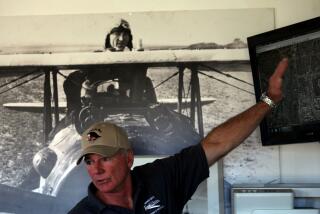FOUNTAIN VALLEY : Fliers Will Take to Skies on Grand Scale
- Share via
Poised on the runway, the Vietnam-era Skyraider fighter plane looked for all the world like it was ready for battle, down to the machine guns tucked under its 90-inch folding hydraulic wings.
Nearby was a DeHavelland Twin Otter, a civilian plane used to transport executives of Canada’s famed retailer, the Hudson Bay Co.
But these were scale-model aircraft, entered in the 14th annual U.S. Scale Masters Championships at Mile Square Park. Thursday, they were judged on their looks. This weekend, 50 pilots from the United States, Canada, Germany, England, Brazil and elsewhere will be rated for their ability to fly the aircraft.
“These are the top guns of model airplanes. These are the best builders and fliers in the world of scale-model aircraft,” said Larry Judson of Fountain Valley, the event spokesman and a model plane instructor.
The event continues today through Sunday in the park’s Hobby Area and is free to spectators. The park charges $2 for parking.
The radio-controlled aircraft include the most intricate detail. Some take builders as long as two years to complete and cost them thousands of dollars. Some planes weigh up to 55 pounds, have 15-foot wingspans and reach speeds of 200 m.p.h.
Sponsored by The Scale Squadron of Southern California Inc., the contest was founded by Harris Lee, 71, an ex-Navy pilot from Oceanside. The event features World War I vintage planes, World War II bombers, dated civilian aircraft and late-model fighters.
Bob Olson of Newport Beach, a model plane builder for the past 30 years, competes not only for recognition, but also the sheer thrill of flying his one-of-a-kind World War II dive bomber, a deep gloss blue Curtiss Helldiver.
“It’s a desire to compete to be recognized as a quality builder and flier,” Olson said. “But 90% (of the people) are in it for the enjoyment. If you win, fine. You go home happy.”
Prized planes are judged on their craftsmanship and authenticity. Piloting skills and flight realism are also rated. Maneuvers such as landings must be as precise as the real planes.
Pilots said the hobby gets in their blood. Once they try it, they can’t quit flying.
“We just love airplanes,” said Diego Lopez of Corona, owner of the Vietnam-era Skyraider, which took him two years to build, including 27 weeks alone for the folding wings. “Sometimes we take better care of our airplanes than we do our kids and wife.”
While getting hooked on the hobby is easy, mastering the flying techniques can be difficult.
“I’ve had a lot of hobbies, and the challenge just wasn’t there. With this, as soon as the plane leaves the ground, it’s a challenge to get it back on the ground safely,” said Bob Boswell of Hamburg, N.J.
Pilots said the most disheartening part of the hobby is dealing with the possibility of crashing their flying works of art.
Eduardo Esteves of Brazil said he nearly cried when his sharp red and black Rearwind Skyranger, a 1941 American civilian plane with a 109-inch wingspan and wood prop, took a dive. It took two months to rebuild the plane.
Boswell agreed: “You have to have the attitude that somewhere, sometime, the plane’s got a date with the ground. I don’t want to see it happen, but it’s part of the hobby.”
More to Read
Sign up for The Wild
We’ll help you find the best places to hike, bike and run, as well as the perfect silent spots for meditation and yoga.
You may occasionally receive promotional content from the Los Angeles Times.






